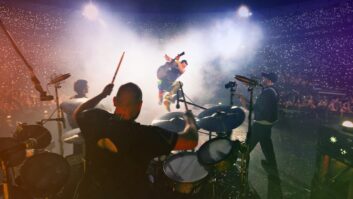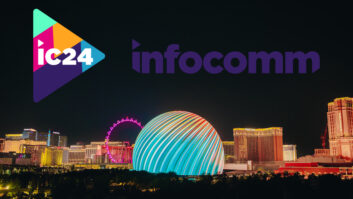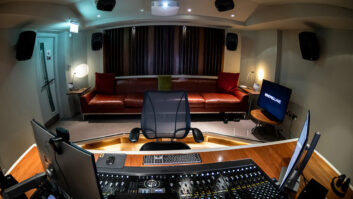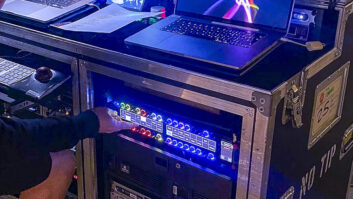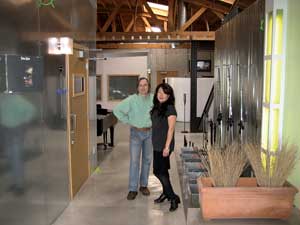
resonate owner John Van Nest and studio manager Terri Wong-Swanson
Many moons ago, when I was the West Coast A&R rep for Clive Davis’ Arista Records, I made regular visits to Hollywood’s Allen Zentz Recording, where producer Harry Maslin worked, often with chief engineer/studio manager John Van Nest. In 1983, Maslin and Van Nest would buy the place and rename it Image Recording, operating together at that location until December 2004. But this was two years earlier, and Maslin was working with Air Supply, a group I’d made Davis aware of (no, my job didn’t necessarily reflect my own taste) during the Aussie duo’s run of seven straight Top 10 singles, all but the first produced by Maslin at Zentz/Image.
I recently got an e-mail from Van Nest — our first contact in 28 years — informing me he’d opened his own two-room Burbank facility, which he’d named “resonate” (with a lower-case “r”) in January 2005. He invited me to take a look at the place, and I headed to Burbank’s Media Center on a glorious spring afternoon. The studio was hard to miss: The 1920s building — once a Nash dealership — has been renovated in the industrial-modern style, with lots of glass and exposed brick.
Enter resonate and the first thing that catches the eye is a block of text on the frosted-glass left wall of the waiting area. It turns out to be a credo Van Nest had written for the studio’s opening, which begins with a reference to The Beatles’ historic appearance on The Ed Sullivan Show on February 9, 1964. “The Beatles’ promise was that music could mean so much to so many,” it reads in part. “That music could resonate so very deeply in our hearts and our minds.” Projected nonstop onto the glass is footage of their performance that night. What a cool way to inspire those who enter to make music.
Van Nest enters the foyer through a diaphanous curtain. We immediately recognize each other despite the passage of nearly three decades, which we both find reassuring, for obvious reasons. He gives me a tour of the space. An architect drew up the blueprints from his detailed plans, and George Augspurger lent his expertise in the wall design of the studios and control rooms. Otherwise, it was all Van Nest’s doing, and he’s understandably proud — the place is inviting and comfortable. “I really wanted to create something that was different from the typical studio — more contemporary, in terms of both environment and functionality,” he explains.
The interior has been completely opened up, including the arched, beamed ceiling, with lounges, seating areas filled with coffee-table books and a large central space complete with baby grand piano surrounding the two studios, which loom in the expanse like free-standing bungalows. Their sheet-metal exteriors are decorated with vinyl albums, each held in place by powerful magnets. Albums are everywhere: in rows of metal bins, in translucent shelving units, by the toilet in one of the bathrooms. The other bathroom has a chic portable record player and a stack of vintage singles. The albums turn out to be the bulk of Van Nest’s collection, which he transported from his house, to his wife’s great relief.
Studio A is a traditional analog mixing/overdubbing suite, built around the 1986 SSL 4000E console that had been the centerpiece of Image, surrounded by the typical complement of outboard equipment from Neve, UREI, Lexicon, AMS, etc. Chris Lord-Alge mixed hundreds of records on the console between 1989 and 2004, and when Van Nest moved it to resonate, the mix master followed. Using A as his home base, Lord-Alge mixed projects from the likes of U2, Green Day, Daughtry and Celine Dion until last year, when he finally moved to be closer to home. Recent clients include breakthrough act Kevin Rudolf, Alice in Chains, producers Toby Wright and Phil Vanali, Demi Lovato, the upcoming Fox TV series Glee and American Idol contestant Paul Kim.
Studio B is a hybrid Pro Tools mixing/overdubbing suite, outfitted with a Digidesign D-Control worksurface that interfaces with movable racks of vintage analog gear from Pultec, Neve, Manley and Pendulum, and 5.1 monitoring by Westlake. It was here that Van Nest edited Leonard Cohen’s Live in London and an upcoming DVD of Madonna’s Hard Candy tour; painstakingly re-created — by ear — the mixes for Mötley Crüe’s 1989 LP Dr. Feelgood for Rock Band; and cut vocals on the initial project of 17-year-old Filipina singer Charice, a David Foster discovery. Additionally, the room has been the site of a considerable amount of work for various Disney artists (including Miley, Vanessa, Ashley and Zac), and the upcoming Chipmunks movie.
“The big question,” says Van Nest, “is how does a modern-day studio interface with all these artists and engineers who work at home? This room was my attempt to bridge the gap. Clients just bring their Pro Tools drive over, their mix comes right up on the ICON, they can choose a great vocal chain with all this gear and a mic from our collection, and when they’re done, they pull the drive out and go home. We get a fair amount of business that way, primarily through word of mouth. You have to change with the times.”
On the way out, I take another look at Van Nest’s credo. It ends with these words: “Your life has brought you here to this place at this time. Make something of it! Your audience is counting on you. And I am, too. So get to it. Make your own promise.”
That’s precisely what he’s done here. It’s great to reconnect with a onetime colleague so many years later to find him still doing what he loves and doing it well.
Send L.A. news to
[email protected]

